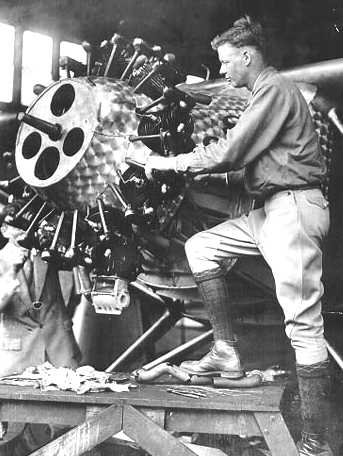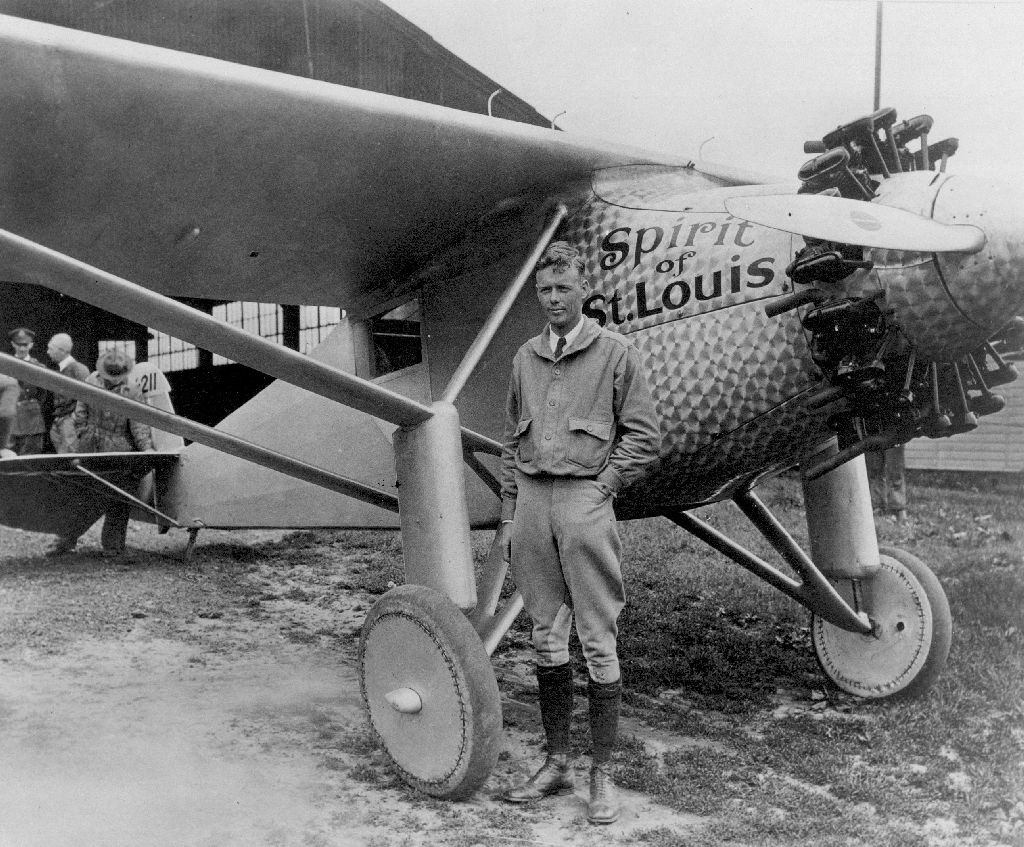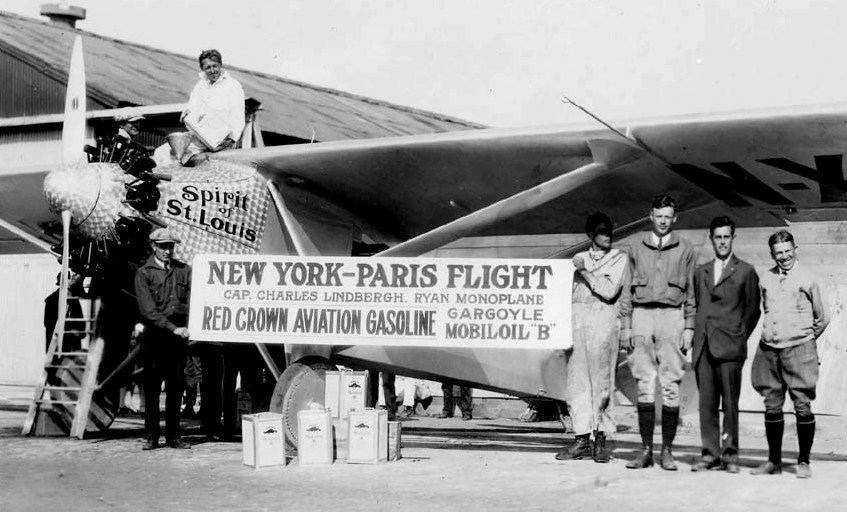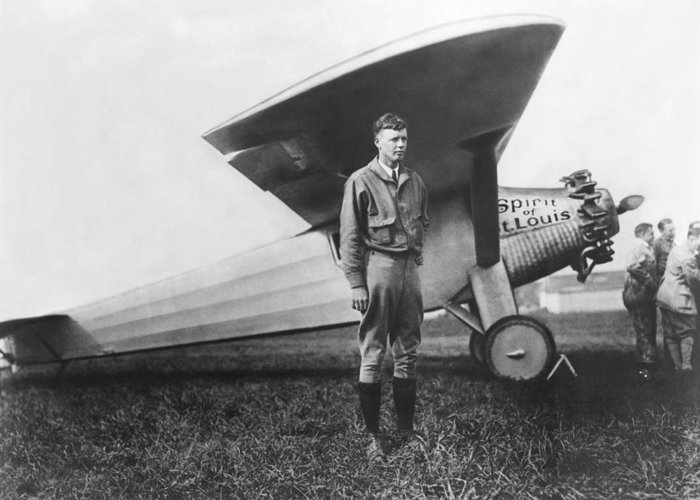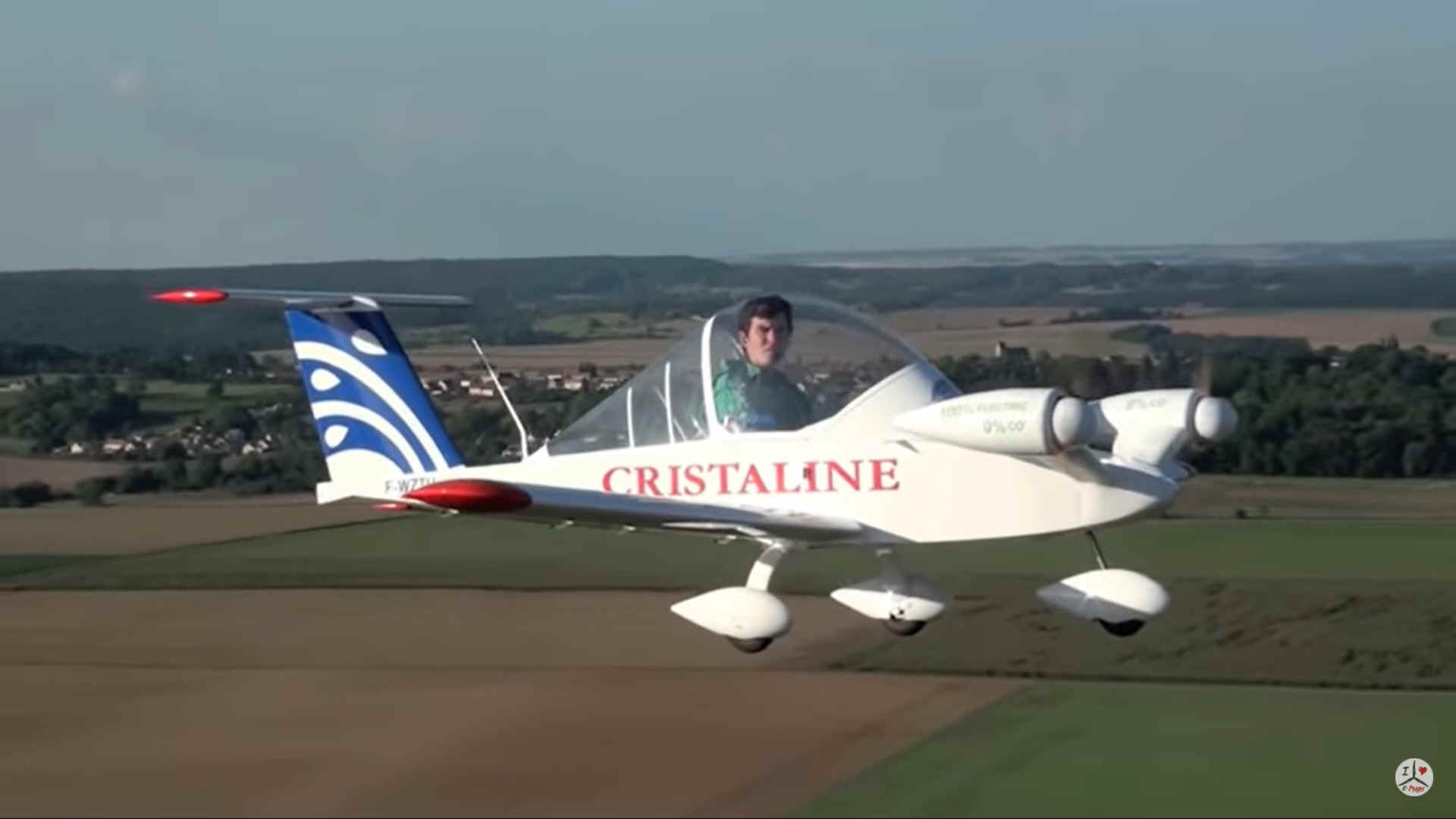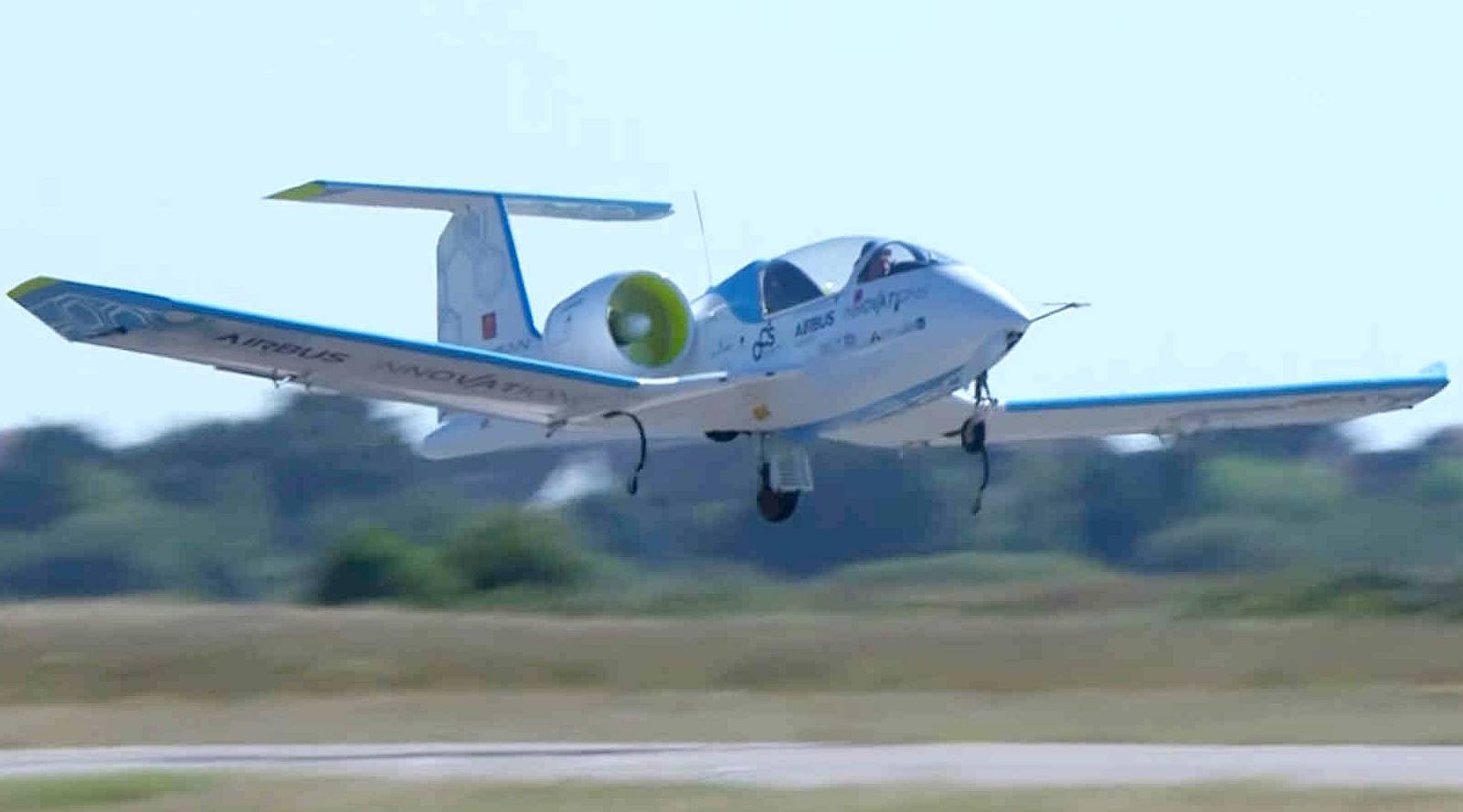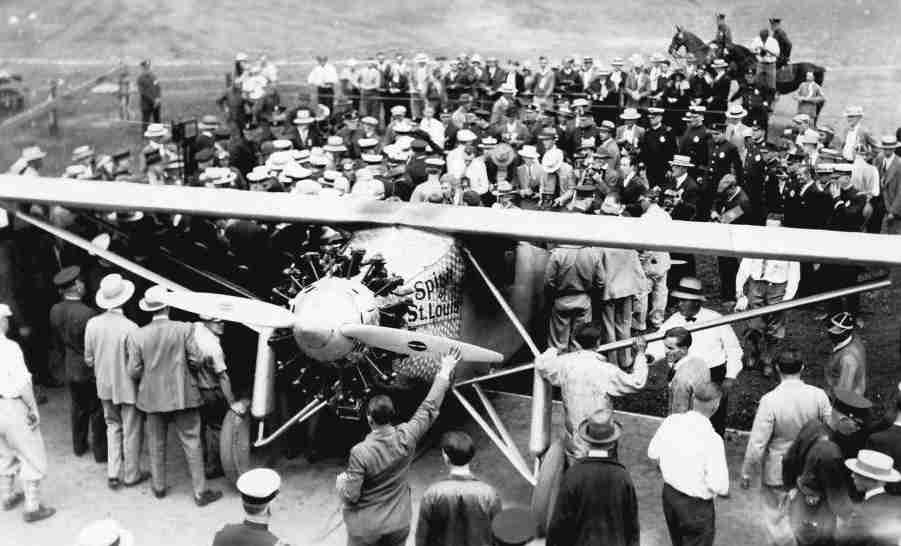|
THE SPIRIT OF ST. LOUIS
AUTOMOTIVE A TO Z CLIMATE CHANGE FUEL CELLS HYDROGEN LANDING PAGE SPEEDACES A- Z UTILITIES
Charles
Lindbergh working on the radial engine of the Spirit of St. Louis. He was an
excellent mechanic. After
the Wright
Brothers conquest of the air at Kitty
Hawk in 1903, the next major air conquest was from Calais to Dover across the English
Channel. The successful pilot was Louis Bleriot in a monoplane of his own
design: Bleriot XI on the 25th of July 1909. The fight took 37 minutes, and it
changed the course of the world. The
next big Pond was the Atlantic Ocean. Enter Charles Lindbergh. Charles was not
an aircraft designer, but he was a good pilot and a persuasive salesman who
inspired others. Lindbergh was a pilot who lived in St. Louis, USA, so
naturally, he'd want to set off from the States, but he had no money. $25,000
DOLLAR PRIZE - BUT WHICH DIRECTION ? In 1919 Raymond Orteig, a Frenchman who owned the Brevoort and Lafayette hotels in New York City, made the fledgling flying world an extraordinary offer. Enthralled by tales of pioneer aviators, Orteig put up a purse of $25,000 to the first aviator to fly nonstop from Paris to New York or New York to Paris. Orteig said his offer would be good for five years. Five years came and went. No one accomplished the feat. No one even tried. In 1926, Orteig extended the term of his offer another five years. This time around aviation technology had advanced to a point where some thought it might actually be possible to fly across the vast
Atlantic. Charles A. Lindbergh was one of them. As a youth, Lindbergh studied with fascination the World War I flying exploits of French ace Rene Fonck who had shot down 75 German planes in the war. In September 1926, Fonck set his sights on crossing the Atlantic from New York to Paris and claiming Orteig's bounty. It was not to be. Fonck's plane, a silver biplane with a luxurious cabin, burst into flames before it even left the ground. Fonck survived the crash, but two crew members were killed. In 1926 Charles Lindbergh had not yet achieved the level of acclaim of his more illustrious flying counterparts. He had, however, gained a reputation as a talented flyer. His experience as a daredevil barnstormer, expert mechanic, and intrepid airmail pilot made many within the relatively small community of flyers take notice. As important, Lindbergh was full of the confidence necessary to undertake such a bold adventure. "Why shouldn't I fly from New York to Paris? ...I have more than four years of aviation behind me, and close to two thousand hours in the air. I've barnstormed over half of the forty-eight states. ...Why am I not qualified for such a flight?" he later wrote in his autobiographical book, "The Spirit of St. Louis." Lindbergh convinced himself that he was qualified for such a flight, and set his sights upon convincing others.
Lindbergh's reputation as an ace pilot was unassailable in St. Louis. He had pioneered the airmail routes between that city and Chicago. Harry Knight, president of the St. Louis Flying Club, had great respect for Lindbergh. So much so that Knight chose Lindbergh as his personal flight instructor. Lindbergh, in turn, came to Knight when seeking backers for his proposed flight. Knight put Lindbergh in contact with the head of the St. Louis Chamber of Commerce, Harold Bixby. Meeting with Bixby, Lindbergh predicted great things for St. Louis if the city were to put its support behind such an historic flight. Painting a picture of St. Louis as an aviation hub, Lindbergh convinced Bixby to sponsor his flight. A budget of $15,000 was agreed upon. NAMING "Spirit of St. Louis" was named in honor of Lindbergh's supporters in St. Louis, Missouri, who paid for the aircraft. "NYP" is an acronym for "New York-Paris," the object of the
flight. SINGLE
ENGINED PLANE With his backers entrusting in him their full confidence, Lindbergh set off to find the right plane. His notion of what constituted the right plane for such a flight put him at odds with the prevailing ideas of the day. While other aviators were placing their faith in the increased power and purported safety of multi-engine planes, Lindbergh determined that multiple engines increased, rather than decreased, the odds of failure. "I'm not sure three engines would really add much to safety on a flight like that. There'd be three times the chance of engine failure," he later recorded. For his transatlantic attempt, he sought out a single-engine plane. And he would be flying alone. His equation was simple: less weight (one engine, one pilot) would increase fuel efficiency and allow for a longer flying range. After failing to convince several airplane manufacturers of the rightness of his thinking, Lindbergh was told of a single-engine plane owned by the Columbia Aircraft Corporation of New York that could be his for $15,000. That sum excluded an engine. Still, Lindbergh wanted the plane. He walked away from the deal, however, when Columbia Aircraft Corporation president Charles Levine insisted on choosing the pilot and crew. Nineteen-twenty-six had turned into 1927, and Lindbergh was running out of time. Other aviators were progressing with tests and flight plans, and Lindbergh still didn't even have a plane. RYAN
AIRLINES CORPORATION Ryan Airlines was housed in a broken down building that used to be a fish cannery. A discouraging stench filled the air. After meeting with Mahoney and Hall, however, Lindbergh's spirits were much improved. The men voiced full confidence in Lindbergh's choice of a single-engine plane and Lindbergh was won over by their apparent skill and dedication, even after he informed them that the plane would have to be completed in two months, not three. From that moment on, Donald Hall practically lived at Ryan Airlines. His commitment was matched by that of his staff, as voluntary overtime became the norm. These men sensed they were becoming part of something historic. DEDICATED
DESIGN "The Spirit of St. Louis" was designed with one thought in mind: to get to Paris. Extra fuels tanks were added and the wing span increased to accommodate the additional weight. The plane would have a maximum range of 4,000 miles, more than enough to reach Paris. One of the more innovative design decisions involved placing the main fuel tank in front of, rather than behind, the pilot's seat. Lindbergh didn't want to be caught between the tank and the engine if the plane was forced to land. This configuration also meant that Lindbergh would not be able to see directly ahead as he flew. It didn't seem to trouble him much. "There's not much need to see ahead in normal flight," Lindbergh told Donald Hall. "I won't be following any airways. When I'm near a flying field, I can watch the sky ahead by making shallow banks. All I need is a window on each side to see through..." If needed, Lindbergh would use a periscope attached to the plane's left side to see what was in front of him. In his efforts to pare down the plane's weight, Lindbergh considered every detail. Any item considered too heavy or unnecessary was left behind. These included a radio, parachute, gas gauges, and navigation lights. Lindbergh designed for himself special lightweight boots for the flight, and went so far as to cut his maps down to include only those reference points he would need. Every ounce mattered. Instead of a heavy leather pilot's seat, Lindbergh would be perched in a far lighter wicker chair. COMPLETION
28 APRIL 1927 "Lucky
Lindy" and his "Spirit of St. Louis" landed at Curtiss Field on Long Island, New York, on May 12, 1927. En route, pilot and plane had already broken the existing record for the fastest transcontinental flight. Eight days later, Lindbergh and his silver plane were poised to set new records as they took off from Roosevelt Field. Fighting fog, icing, and sleep deprivation, Lindbergh landed safely at Le Bourget Field in Paris at 10:22pm on May 20, 1927. "The Spirit of St. Louis" had carried him over 3,600 miles in 33.5 hours. A new aviation hero was born, and the "Spirit of St. Louis" attained legendary status. MAY
- JUNE 1928 Then in
1928 Sir
Charles Kingsford Smith crossed the Pacific
Ocean from Oakland, California, via Mana, Hawaii to Brisbane, also completing
a World Circumnavigation
in 1930. The ladies got a look in with the exceptional achievement of Amy
Johnson in 1930 she managed Croydon, London to Brisbane, Australia solo. GOING ELECTRIC Then
came Hughes Duwal on the 9th of July 2015, in his electrically propelled
Colomban E-Cristaline, pipping Airbus to the post with their E-Fan on the 10th
of July 2015. Both
these craft used lithium batteries. The range of these aircraft can be doubled
by using hydrogen batteries. LINKS
& REFERENCE http://www.elizabethqueenseaswann.com/TransAtlantic_Solar_Powered_Autonomous_Records_Attempt.html http://www.solarnavigator.net/aviation_and_space_travel/charles_lindbergh.htm http://elizabethqueenseaswann.com/Events_Records_Attempts_Solar_Powered/Cross_Channel
....
Copyright
© website 2023, all rights reserved, save for educational and media
review purposes. You do not need permission to use our information if it
is to help promote a low carbon economy. This is a low carbon website that
loads quickly and is as kept simple as possible while still providing
useful information. Cleaner
Ocean Foundation Ltd and Climate
Change Trust.
|
